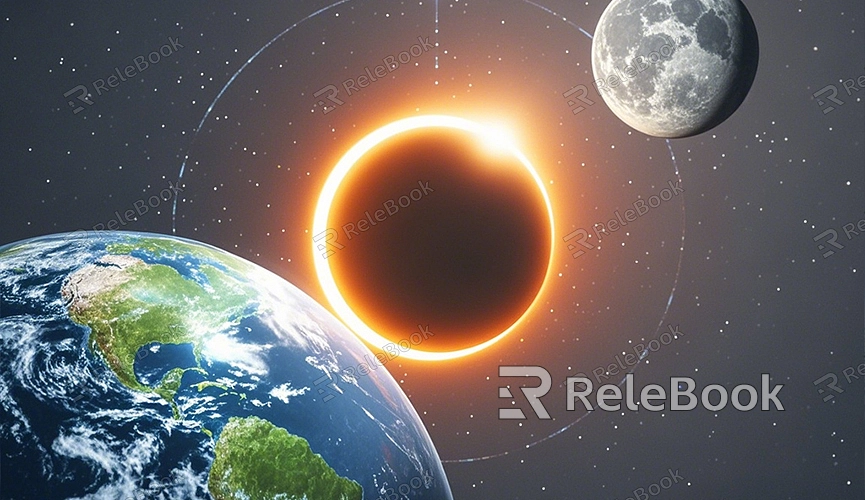How to Make a 3D Model of a Solar Eclipse
A solar eclipse is a spectacular astronomical event that occurs when the moon moves between the Earth and the Sun, blocking the Sun’s light. For astronomy enthusiasts and 3D artists, creating a 3D model of a solar eclipse is not only an engaging challenge but also a way to explore and showcase the mysteries of the cosmos. This guide will detail how to create a 3D model of a solar eclipse using Blender, covering key steps and techniques.
Understanding Solar Eclipses
Before creating a 3D model of a solar eclipse, it's essential to understand the basic principles of the phenomenon. A solar eclipse occurs when the moon's shadow falls on the Earth's surface as it moves into alignment between the Earth and the Sun. This geometric relationship determines the unique perspective and light-shadow effects of the eclipse. Thus, accurate celestial positioning and light simulation are crucial for modeling a solar eclipse.

Basic Steps to Create a Solar Eclipse Model
1. Position the Celestial Bodies
In Blender, start by creating a scene that includes the Sun, Moon, and Earth. Use spheres to represent these three celestial bodies. Name the spheres “Sun,” “Moon,” and “Earth” respectively, and adjust their sizes and positions based on astronomical data. Ensure that the Moon is positioned between the Sun and Earth and slightly offset to simulate the Moon blocking the Sun.
2. Apply Lighting and Shadows
To simulate the eclipse, lighting and shadows are essential. In Blender, use a strong light source to represent the Sun. Place the light source at the location of the Sun sphere to illuminate the Moon and Earth. Adjust the intensity and direction of the light to cast realistic shadows, mimicking the effect of the Moon blocking the Sun’s light on the Earth's surface.
3. Add Surface Textures
For a realistic model, adding surface textures to the celestial bodies is vital. Assign materials and textures to the Sun, Moon, and Earth. The Sun can use an emissive material, while the Moon and Earth require detailed surface textures.
- Moon Surface: Choose a realistic texture that displays craters and mountains. If you need high-quality 3D textures and HDRIs for creating models and virtual scenes, you can download them for free from [Relebook](https://textures.relebook.com/), which offers a wide range of premium 3D resources.
- Earth Surface: The Earth's surface texture should include details of oceans, landmasses, and the atmosphere to enhance the model’s visual appeal.
4. Adjust Camera Perspective
The camera perspective determines how you present the solar eclipse. Position the camera either on the Earth's surface or outside the atmosphere to view the Moon as it gradually obscures the Sun. To better showcase the eclipse, you can adjust the camera’s focal length and angle to capture the Sun’s flares and the Moon’s silhouette.
Animation and Rendering

1. Create a Solar Eclipse Animation
If you want to show the entire eclipse process, you can create an animation in Blender. Start by setting up the Moon’s orbital path so it moves between the Sun and Earth. Use keyframes to record the Moon’s position changes, simulating the progression of the eclipse from start to finish. During this process, the shadow will gradually cover the Sun and eventually reveal it again.
2. Render the Solar Eclipse Animation
Once the animation is complete, the next step is rendering. Before rendering, ensure you set the correct output format and resolution. It’s recommended to use MP4 or other common video formats for better animation display. Additionally, enable Blender’s Cycles rendering engine for higher light and shadow accuracy, ideal for depicting the complex lighting of an eclipse.
Resources and Tips
Using high-quality textures and lighting effects can significantly enhance the realism of your solar eclipse model. For exquisite 3D models, visit [Relebook](https://3dmodels.relebook.com/), which provides a vast selection of premium 3D resources. Relebook also offers a rich collection of HDRI images to help create more realistic lighting effects in your virtual scenes.
Pay close attention to detail during the modeling process. Ensure that the proportions and motion paths of the celestial bodies are accurate and continuously adjust the lighting and shadows to achieve the best visual results.
By following these steps, you can create a realistic 3D model of a solar eclipse in Blender. This process not only illustrates the astronomical principles of an eclipse but also vividly recreates the event through animation and rendering techniques. With the help of high-quality textures and model resources from Relebook, your 3D model will be more professional and expressive. If you need high-quality 3D textures and HDRIs, you can download them for free from [Relebook](https://textures.relebook.com/), which offers a wealth of premium resources.

